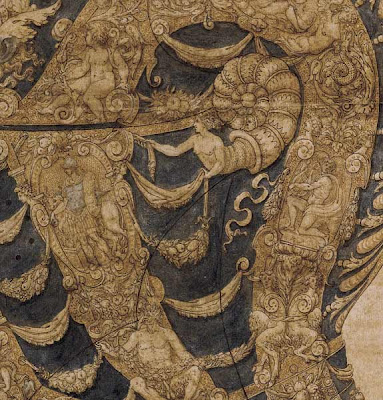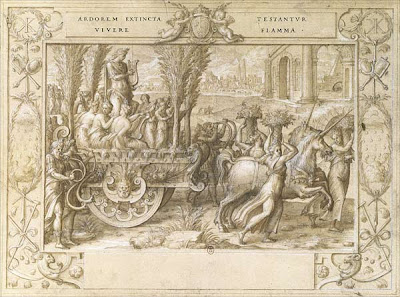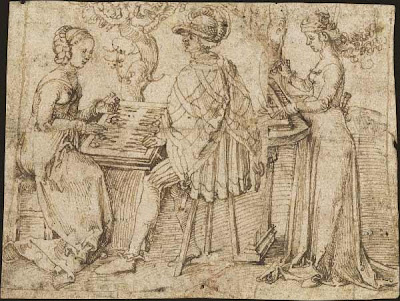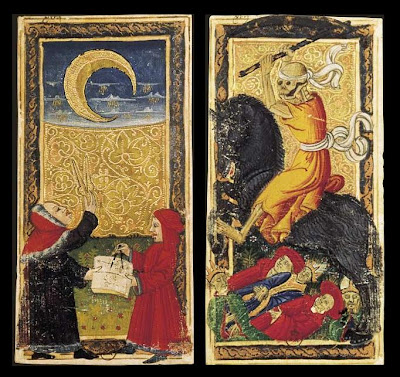Known as the Charles VI Tarot Deck these late 15th century hand painted cards are among 17 that have survived from a series produced in northern Italy and here depict the fool, the hangman, the moon and death. It's also known as the Gringonneur deck after the artist from the end of the 14th century who is said to have painted (some of?) the earliest tarot decks for King Charles VI. These cards are certainly an example from a very early tarot work but I'm not sure where they sit in an historical sense - a quick look around the web didn't identify any standout authorities for me. In any event, this deck appears in the present exhibition site as an example of how allegorical, emblematic and symbolic iconography from the renaissance circulated in popular (if elite) form. [Tarot].

Helmet design sketch (and detail) in the mannerist style from ~1575 by Andrea Casalini for a suit of armour for Alexander Farnese, Duke of Parma and Governor-General of Holland. The exuberant decoration and presentation of a war accessory as an artistic object reflects a wider emergence of tournaments, festivals and processions of armies as subjects for aesthetic presentation.

Nicolo dell'Abate sketch and detail from ~1563 - 'Le Char des Licornes' (The Unicorn Chariot) - featuring motifs and mythological imagery from the antiquities. The sketch was the basis for a tapestry featuring Marie de Medici and Henri IV. Dell'Abate was one of the italian artists who helped to disseminate italian renaissance/mannerist styles to France via the School of Fontainebleau (see: i, ii, iii).

Pierre Jacques, a sculptor from Reims, spent about 5 years in Italy in the 1570s. He produced an album of sketches of ancient roman statue features. The whole album is online at BNF [the 2nd image above was nabbed from here] and if anyone is keen (and reads french) there is a long article from 1894 here in page image format, establishing the date and bona fides of the author and subject matter and its importance in the development of the french renaissance etc ('etc' means that it was eventually a bit over my head both in content and language).
René Boyvin (previously) was also strongly connected to the School of Fontainebleau and the 2 figures here depict a torch carrier and a masquerade character sketch. {2nd half of 16th century}
This sketch by Albrecht Dürer from 1492/3 consists of 2 fragments, a couple playing backgammon and the standing woman playing checkers. They were designs for stained glass pieces, a field in which artisans from southern Germany excelled during a transition from gothic to renaissance characteristics. A certain simplicity of drawing style was required for the stained glass work, a skill Dürer would again employ to great success with wood and metal engraving.
It was quite by accident that I chose these 2 François Clouet portraits or at least, I wasn't aware that Élisabeth d'Autriche (Austria) [1571], who married into the french Royal Court and Élisabeth de Valois [1559] who married into the spanish Royal Court both had similarly unhappy lives. Élisabeth de Valois married at age 14 and died during childbirth aged 23. Élisabeth d'Autriche married the (mad) Charles IX and when he died 4 years later, she retreated to her homeland rather than remarry and continue life at Court. François Clouet replaced his father as the official portraitist for the french Royal Court in 1540. His drawings are considered masterpieces for their simplicity, exquisite beauty and accuracy.
'Défilé des funérailles du roi Mausole : Chevaux caparaçonnés' (~1570) by Henri Lerambert was also a product of the School of Fontainebleau. The funeral procession of ancient greek King Mausolus was the basis for a tapestry. The grid lines seen in the sketch allowed squares to be enlarged to their final size after the design was accepted. (See: i, ii, iii)
The allegorical virtues Prudence and Justice (~1550) by Giulio Campi , a leading mannerist artisan of the Cremona group in Lombardy, Italy.
The 'Dessins de la Renaissance' exhibition site at BNF has an extensive collection of drawings, essentially exploring how the themes of the renaissance spread through France. Lucky you if your french reading skills are strong. Most, if not all, the library stamps were removed and I did a very minimal amount of artifact cleaning in a few of these.
The satirical prints below have nothing at all (well, directly anyway) to do with the renaissance and come from a site to note for the future - British Printed Images to 1700, being developed by a number of British repositories. At present there are only about 10 prints available but they give the impression that this will be a formidable and exemplary site when the planned 10,000 prints have all been put online. [via]


'This Costly Fish Catcht In's Weil All These Desire To Tast As Wel As Feele. at All times in Season' {a 'Weil' is a kind of lobster pot - a metaphor for marriage} (from about 1682 but it is a variation on a motif with a convoluted history)
Doll heard what each man said,
She vext, and was half dismaid,
Hold, she cried tis time I think
To cut the cord; let her sink.
You all strive to set her free,
Not one of you will pull for mee.
























1 comment :
I see that low-rider underwear was not unknown in the Renaissance either, although perhaps in those days it was only worn by the Fool (actually, these days I suppose it is the combination of high-rise underpants with low-rise jeans that is so notable; and on the female of the species rather than the male).
Be as that may, I am always partial to the Fool card, and also to the Hanged Man. The others are often just as beautifully rendered, but not always so intriguing.
Post a Comment
Comments are all moderated so don't waste your time spamming: they will never show up.
If you include ANY links that aren't pertinent to the blog post or discussion they will be deleted and a rash will break out in your underwear.
Also: please play the ball and not the person.
Note: only a member of this blog may post a comment.